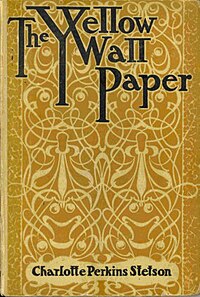"The Yellow Wallpaper" (original title: "The Yellow Wall-paper. A Story") is a short story by American writer Charlotte Perkins Gilman, first published in January 1892 in The New England Magazine.[1] It is regarded as an important early work of American feministliterature, due to its illustration of the attitudes towards mental and physical health of women in the 19th century.
Narrated in the first person, the story is a collection of journal entries written by a woman whose physician husband (John) has rented an old mansion for the summer. Forgoing other rooms in the house, the couple moves into the upstairs nursery. As a form of treatment, the unnamed woman is forbidden from working, and is encouraged to eat well and get plenty of air, so she can recuperate from what he calls a "temporary nervousdepression – a slight hysterical tendency", a diagnosis common to women during that period.[2][3][4]
Plot summary
The story details the descent of a young woman into madness. Her supportive, though misunderstanding husband, John, believes it is in her best interests to go on a rest cureafter experiencing symptoms of "temporary nervous depression". The family spends the summer at a colonial mansion that has, in the narrator's words, "something queer about it". She and her husband move into an upstairs room that she assumes was once a nursery. Her husband chooses for them to sleep there due to its multitude of windows, which provide the air so needed in her recovery. In addition to the couple, John's sister Jennie is present; she serves as their housekeeper. Like most nurseries at the time the windows are barred, the wallpaper has been torn, and the floor is scratched. The narrator attributes all these to children, as most of the damage is isolated to their reach. Ultimately, though, readers are left unsure as to the source of the room's state, leading them to see the ambiguities in the unreliability of the narrator.
The narrator devotes many journal entries to describing the wallpaper in the room – its "yellow" smell, its "breakneck" pattern, the missing patches, and the way it leaves yellow smears on the skin and clothing of anyone who touches it. She describes how the longer one stays in the bedroom, the more the wallpaper appears to mutate, especially in the moonlight. With no stimulus other than the wallpaper, the pattern and designs become increasingly intriguing to the narrator. She soon begins to see a figure in the design, and eventually comes to believe that a woman is creeping on all fours behind the pattern. Believing she must try to free the woman in the wallpaper, the woman begins to strip the remaining paper off the wall.
After many moments of tension between John and his sister, the story climaxes with the final day in the house. On the last day of summer, she locks herself in her room to strip the remains of the wallpaper. When John arrives home, she refuses to unlock the door. When he returns with the key, he finds her creeping around the room, circling the walls and touching the wallpaper. She asks excitedly, "I've got out at last,...in spite of you and Jane?", and her husband faints as she continues to circle the room, stepping over his inert body each time she passes, seeming to have become the personification of the woman trapped behind the yellow wallpaper.

Tidak ada komentar:
Posting Komentar